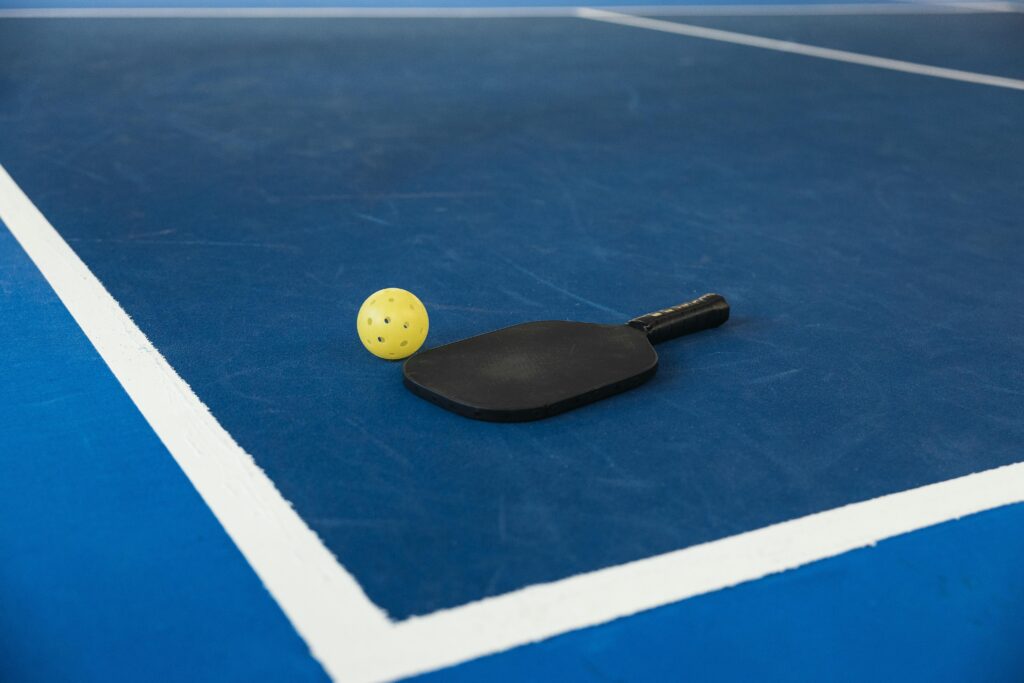In the buzzy sports landscape of India, a new contender has emerged, captivating enthusiasts and newcomers alike—pickleball. This relatively unknown sport has been quietly gaining momentum and is now on the verge of becoming India’s new favourite pastime. But what is it about pickleball that has captured the hearts and minds of so many? Let’s dive into the fascinating rise of pickleball in India, exploring its appeal, benefits, and the burgeoning community that supports it.

The Origins and Basics of Pickleball
Pickleball is a paddle sport that combines elements of tennis, badminton, and table tennis. It is played with a perforated plastic ball on a badminton-sized court with a slightly modified tennis net. Originating in the United States in the mid-1960s, pickleball was designed to be easy to learn and accessible to all ages and skill levels.
In India, the simplicity and inclusiveness of pickleball have made it an attractive option for those looking for a new way to stay active and have fun. The sport’s rapid learning curve means that players can quickly go from novices to competent competitors, which has contributed significantly to its growing popularity.
Accessibility and Affordability
One of the primary reasons pickleball is gaining traction in India is its accessibility. Unlike sports that require extensive equipment or specialized venues, pickleball can be played on any flat surface, such as badminton courts, tennis courts, or even community halls. This versatility has made it easy for schools, parks, and residential complexes to introduce pickleball to their facilities.
Moreover, the affordability of pickleball equipment—a paddle, a ball, and a net—makes it an attractive option for many. Compared to the costs associated with cricket or tennis, pickleball offers a low-cost entry point, allowing more people from diverse backgrounds to participate.
Health Benefits and Social Engagement
Pickleball is not just a fun game; it also offers numerous health benefits. The sport provides a full-body workout, improving cardiovascular health, enhancing hand-eye coordination, and boosting agility and reflexes. It is also a low-impact sport, making it suitable for people of all ages, including seniors who may find other sports too strenuous.
Additionally, pickleball has a strong social component. The doubles format of the game encourages teamwork and communication, fostering a sense of community among players. In a country where social connections and community involvement are highly valued, pickleball has become a medium through which people can connect and engage with one another.

The Rise of Pickleball Communities
The growth of pickleball in India can also be attributed to the rise of dedicated communities and clubs. These groups are essential in promoting the sport, organizing events, and providing training for new players. Cities like Mumbai, Bangalore, and Chennai have seen the establishment of pickleball clubs that regularly host tournaments and social play sessions.
The Indian Pickleball Association (IPA) has been instrumental in this growth, working tirelessly to promote the sport at the grassroots level. Their efforts have included organizing national championships, and workshops, and partnering with schools and colleges to introduce pickleball to younger generations.
Media Exposure and Celebrity Endorsements
As with many emerging trends, media exposure and endorsements from celebrities have played a significant role in pickleball’s popularity. Local newspapers, sports channels, and social media platforms have begun to highlight pickleball events and success stories, bringing the sport into the mainstream consciousness.
Celebrities and sports personalities endorsing pickleball have also contributed to its appeal. When well-known figures participate in or speak positively about a sport, it garners attention and curiosity from the public. This phenomenon has helped pickleball transition from a niche activity to a popular sport enjoyed by many.
Future Prospects for Pickleball in India
The future looks bright for pickleball in India. With increasing participation rates, expanding community support, and growing media coverage, pickleball is set to become a staple in India’s sports culture. The potential for pickleball to be included in national and international sporting events could further elevate its status and attract even more enthusiasts.
Furthermore, the inclusivity and adaptability of pickleball mean that it can thrive in various settings, from urban to rural areas. As more people discover the joys and benefits of playing pickleball, it is poised to become a permanent fixture in the Indian sporting landscape.
Conclusion
Pickleball’s rise in India is a testament to its universal appeal, accessibility, and the dedicated efforts of passionate individuals and communities. As more Indians embrace this exciting sport, pickleball is not just becoming a new favourite; it is fostering healthier lifestyles and bringing people together. Whether you’re a seasoned athlete or someone looking for a fun way to stay active, pickleball offers something for everyone. Join the movement and see why pickleball is capturing the hearts of so many in India.


